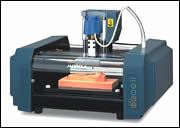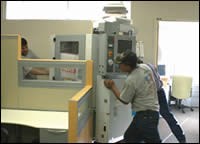Machining Outside The Shop
The Future of Machining - 2005 The number of machine tools operated by non-machinists outside the machine shop will increase.
Share






Takumi USA
Featured Content
View More


Hwacheon Machinery America, Inc.
Featured Content
View MoreMachine tools are becoming smaller and less expensive. CAD/CAM software and 3D scanning technologies are becoming easier to use. As these trends continue, so too will the trend of machining work being performed outside of the traditional machine shop by non-machinists.
Machine tools will be used in hospitals and dental laboratories. They will be used in jewelry makers' shops. They will be used in upper levels of downtown office buildings without disrupting daily business activities.
One of the reasons that machining technology is becoming attractive outside the realm of the metalworking industry is that it offers a way to reduce or eliminate handwork. These often-time-consuming processes are common to components made for medical, dental and jewelry-making applications to name just a few. Another reason for their growing popularity is the chance to eliminate any disconnects or delays resulting from the separation of designer and machine shop. This is accomplished by allowing the part designer to quickly create a prototype on a machine tool located in the CAD department. For some manufacturers, the capability to machine one's own prototypes offers added assurance that proprietary concepts will be kept under wraps.
Smaller Sizes
The main obstacles to installing machine tools in a space such as an office have been the equipment's size and weight. Most machine tools are too heavy for a typical freight elevator to handle and too bulky to fit through a standard 36-inch-wide doorway. Haas Automation (Oxnard, California) is addressing these needs with its Office CNC mills and lathes. Sized to fit comfortably in an office, these machines can be moved with a pallet jack or equipment dolly. Alternately, casters can be installed on the machines for easy maneuverability. These machines operate on 240-volt single-phase power, which any facility should be able to accommodate without much trouble.
Prediction:
The number of machine tools operated by non-machinists outside the machine shop will increase.
According to Dave Hayes, Haas product manager, the Office machines are likely to find themselves in a variety of places where very small parts machining capability is needed. One non-traditional industry where these machines are likely to nest is the jewelry business. A jewelry designer can machine the bulk of a new product's general shape into a wax mold, leaving only fine details to be finished by hand. Another possibility would be to bypass the casting process and machine the actual piece of jewelry from stock. Rings, for example, might be turned on a lathe and then taken to a mill to machine the final details. The goal here is to reduce or eliminate the amount of hand carving in the creation of new jewelry.
A manufacturer or shop that is currently using machine tools to create its parts may also use such very small machines to take prototype machining off of the shop floor and into the CAD department. The result could mean quicker new product development and speedier time to market.
Scanning, Then Milling
The union of machine tools and 3D scanning capability is a marriage of technologies that is driving machining operations to atypical locations, often for rapid prototyping and one-off work. Hospitals and dental laboratories are two of these locations. The ability to directly machine a body part or dental profile, or to create a mold for such parts from a patient's scanned 3D feature, greatly speeds the generation of these unique parts.
For some, the term "rapid prototyping" is synonymous with additive-material processes, such as stereolithography. Subtractive processes, on the other hand, can be just as effective in generating a prototype post-haste and may even be able to produce it in the part's specified material. Such is the case with what Roland DGA Corporation (Irvine, California) calls the subtractive rapid prototyping (SRP) process, which combines a benchtop 3D scanning system with a benchtop milling machine. Among other applications, this system is being used in medical labs by anaplastologists who create prostheses for facial reconstruction. The capability to quickly mill the basic form of a patient's prosthesis allows anaplastologists to focus their clinical energy on the final details that make the prostheses look as realistic as possible. In the case of ear reconstruction, for example, a plaster cast of a patient's good ear can be scanned, mirrored and then milled for reconstructing the damaged ear.
Similar milling/scanning systems are being used to create inlays, crowns, bridges and other dental components. These systems are used in dental labs to scan a patient's damaged tooth, then design the part to fit precisely and mill the actual profile from ceramic or other dental material.
Scanning capability will send machining work to even more unlikely places. These systems would be appropriate for developing new toys, sculptures and a variety of other artistic pieces. For example, one scanning/milling system was used to help create the infamous black mask worn by Darth Vader in "Star Wars Episode III: Revenge of the Sith."
The CAD/CAM developers are helping bridge the gap between artists and machine tools, as well. A number of these companies offer artistic software that can allow users to turn a 2D drawing or sketch into a 3D piece of artwork, and then the software will generate the appropriate tool paths. Software geared specifically to the jewelry-making industry is also becoming available.
Take Away
Shops should take note of these new machining opportunities, but not necessarily because said shops should consider delving into these niche areas and producing their own product lines. What this trend should reinforce in shops is the concept of continuing to offer their customers more than a part completed on spec and on time. These offerings may be in the form of component assembly, combined machining and fabrication under one roof, successful management of a lean supermarket—whatever it takes to give customers more than they thought they needed from a single vendor.
Related Content
Inside the Premium Machine Shop Making Fasteners
AMPG can’t help but take risks — its management doesn’t know how to run machines. But these risks have enabled it to become a runaway success in its market.
Read MoreOrthopedic Event Discusses Manufacturing Strategies
At the seminar, representatives from multiple companies discussed strategies for making orthopedic devices accurately and efficiently.
Read More5 Tips for Running a Profitable Aerospace Shop
Aerospace machining is a demanding and competitive sector of manufacturing, but this shop demonstrates five ways to find aerospace success.
Read MoreHow to Successfully Adopt Five-Axis Machining
While there are many changes to adopt when moving to five-axis, they all compliment the overall goal of better parts through less operations.
Read MoreRead Next
The Post-Machine-Shop Process
Making the transition from batch production to a build-to-order strategy meant removing the kinds of barriers that separated machining from the rest of manufacturing.
Read MoreRegistration Now Open for the Precision Machining Technology Show (PMTS) 2025
The precision machining industry’s premier event returns to Cleveland, OH, April 1-3.
Read MoreBuilding Out a Foundation for Student Machinists
Autodesk and Haas have teamed up to produce an introductory course for students that covers the basics of CAD, CAM and CNC while providing them with a portfolio part.
Read More














































